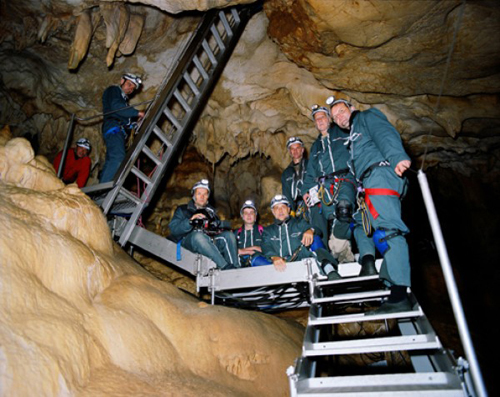Cave of Forgotten Dreams (2011)
90 Min
Director and Narrator - Werner Herzog
Filmed in 3D
More than 30,000 years ago, our human ancestors entered the Chauvet Cave in southern France and, for reasons unknown but pondered about for millennia, they created cave paintings. These are the oldest known paintings to exist. The pictures depict magnificent animals, including lions, horses, rhinos, and extinct cave bears and panthers. The soft cave floor is littered with bones (100% of them are from animals) including many well preserved skulls of the extinct cave bear which would have spent much time in such caves. Beautiful patterns have emerged after thousands of years of slow dripping water and the ambiance is only enhanced by the drastic shift from large chambers with high ceilings to tight spaces with almost no room to move. The cave was first explored in 1994 and due to the fact that it had been sealed by a long ago rock collapse, it was most likely the first time in over 20,000 years anyone had entered the cave.
Werner Herzog has a distinct style, and anyone who has seen some of his films will recognize immediately that this is a Herzog film. As in a favorite film of mine, Grizzly Man, he uses wonderful shots of his subject spliced with entertaining interviews by key figures. He expounds upon the bigger questions such as 'why' did people draw these and what could it have meant in a broader scheme of humanity. Experts are interviewed in various fields of science and the humanities who all bring unique perspectives to the subject matter. There are wonderful asides that touch on similar cave findings, such as bone fragments turned into flute-like instruments, signaling the importance of not just art but music to people throughout time. Anecdotes about the history of the region including the large glaciers which covered the area before melting add a nice touch.
Herzog and his team were hindered greatly by the French government (justifiably) who would only allow filming under the most strict guidelines. Just a crew of 4, shooting for 4 hours per day, for just one week and they were only allowed a few small, battery run lights, all the while confined 100% of the time to a small, 2 foot wide walkway built throughout the cave which no one is allowed to leave for fear of tampering with the well preserved cave. Herzog filmed in 3D which, for the first time in my life, I can say was absolutely the perfect solution to portraying the amazing cave in its entirety. The paintings are made throughout the cave on contoured walls which, it would seem, were purposely put there so as to add to the dimensions and the storytelling of the paintings. Herzog draws a wonderful parallel to what it must have looked like by torchlight 30,000 years ago. There is even evidence that some of the paintings have etchings around them to create depth. Several paintings are drawn with multiple legs and horns, clearly attempting to depict movement among the animals. There is a unique piece of wall covered in red hand prints. Interestingly, there is a distinct defect in the print of the little finger on one of the hands, and this hand can be traced to multiple red hand prints throughout the cave, meaning the team is able to trace the path of a single individual from so many thousands of years ago.
One of the most interesting aspects of the film comes from an area of the cave which cannot be fully seen from the walkway. A partial view of one of only 2 paintings in the cave which depict some form of the human body. It appears to be the lower body of a woman with the head of a bullish creature. Herzog is eventually allowed to place a camera on a long crane to get a better view. It is not so much the shot of the painting that is astounding as is the questions that are raised by such figures. What were our ancestors thinking when they drew these paintings of animals, and more specifically, when they drew this painting of half woman half beast? What did they believe about the world and why were they so interested in recording visually what they saw around them? This is a beautiful film and one enhanced largely via 3D technology.








No comments:
Post a Comment